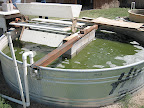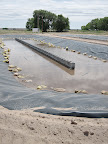We drove into Carlsbad, New Mexico, a little mining and oil town in southeastern New Mexico surrounded by high desert. This humble location is home to one of the world's few algae-based biofuels research organizations.
CEHMM (pronounced "chem" - the Center of Excellence for Hazardous Materials Management) is a research organization whose primary aim is to protect human and environmental health while advancing economic development of the area. If they are successful in their algae work, they will certainly have achieved this goal.
Producing biodiesel from algae requires 4 basic steps:
- Growing the algae
- Harvesting (separating water from algae)
- Extracting the oil from the algae
- Processing the oil into biodiesel
Growing algae is the easy part - algae requires sunlight, water, nutrients, carbon dioxide, and some way to protect the purity and health of the algae.
30 miles north of Carlsbad, in Artesia, NM, on the grounds of New Mexico State University's agricultural research station, reside CEHMM's test ponds. To protect their algae, they are using saltwater algae in a brine - the brine water protects the algae from intruders and keeps the strain fairly pure.
Here is a photo of test pond #1: the paddle wheel both agitates and aerates the algae - providing it with atmospheric CO2.

And here is a photo of the soon to be completed 1/8 acre test pond:

2. Harvesting
These algae ponds reach about 1 gram of (useful) biomass per liter of (useless) water. Getting rid of the water is a difficult step. There are many methods of harvesting algae (see this Wikipedia article on algaculture for other ideas), CEHMM is using a proprietary technology that involves membranes (think: very fine mesh filters that don't clog) to create a very concentrated mixture of water and algae.
3. Extracting
If harvesting is difficult, extracting is extremely difficult. This step is again proprietary (darn NDAs), and I was only given hand-waving explanations of how CEHMM accomplishes this bit. They are apparently looking at two competing technologies - one is able to produce biodiesel directly from the harvested algae by melting cell membranes, etc. I have no idea what other products are made in this process.
Another process they are looking at involves separating the oil from the cell membranes (which can then be composted, used as fertilizer, fed to animals, etc).
4. Processing
If CEHMM chooses to go with the second of the two extraction methods, they will have to process the resulting oil into biodiesel. In a retired gas station in Carlsbad, NM CEHMM has a small scale biodiesel production facility. Here is where they experiment with biodiesel production techniques (and fill up the local fire department with the resulting fuel).
Here is Terry showing off the second ever batch of biodiesel produced from algae. "A group in New Zealand beat us by a week."

I can't wait to see the fruits of CEHMM's research, it is my hope that in the not too distant future, many of us will be driving around on algae-produced biodiesel.

No comments:
Post a Comment